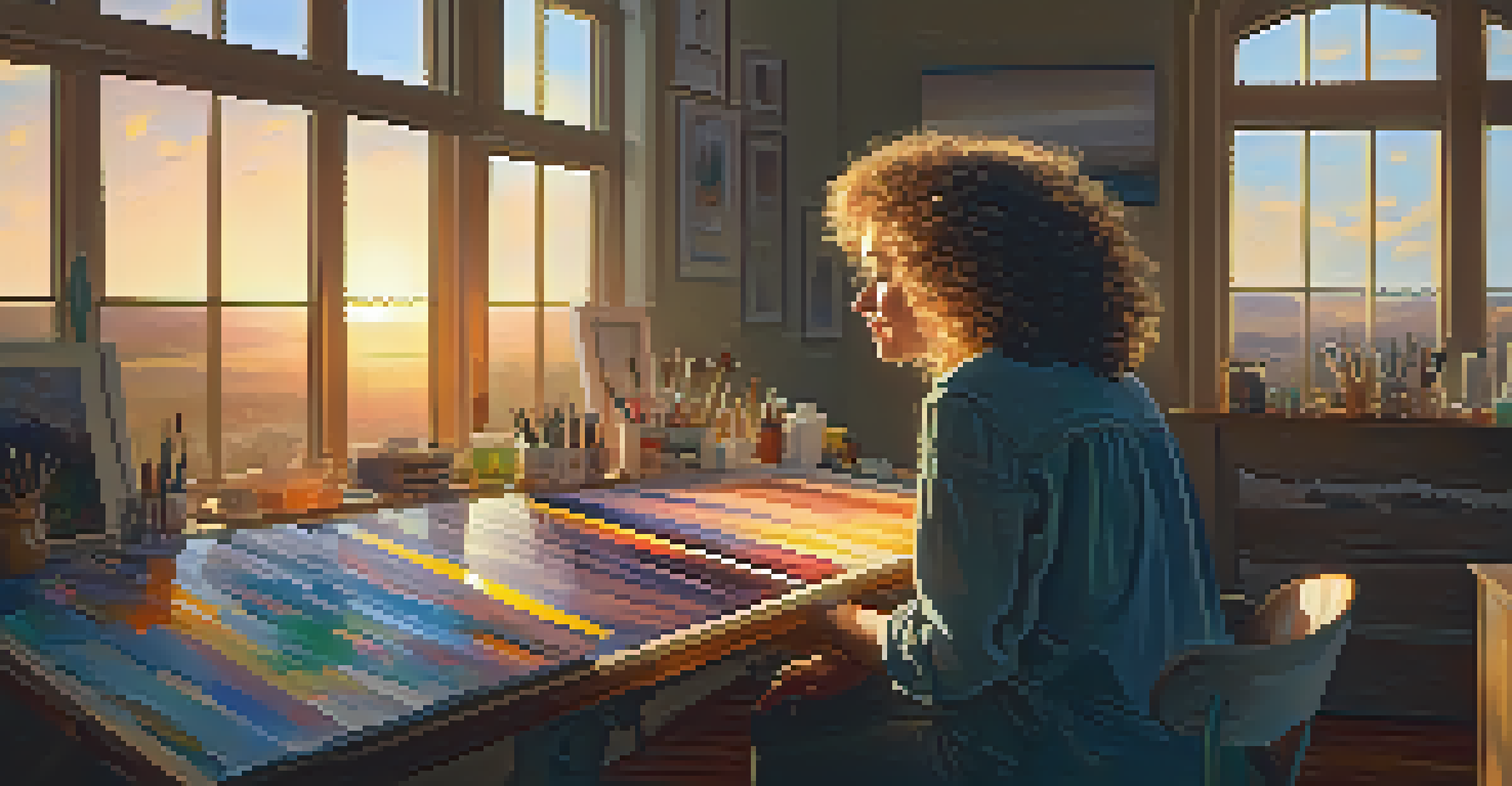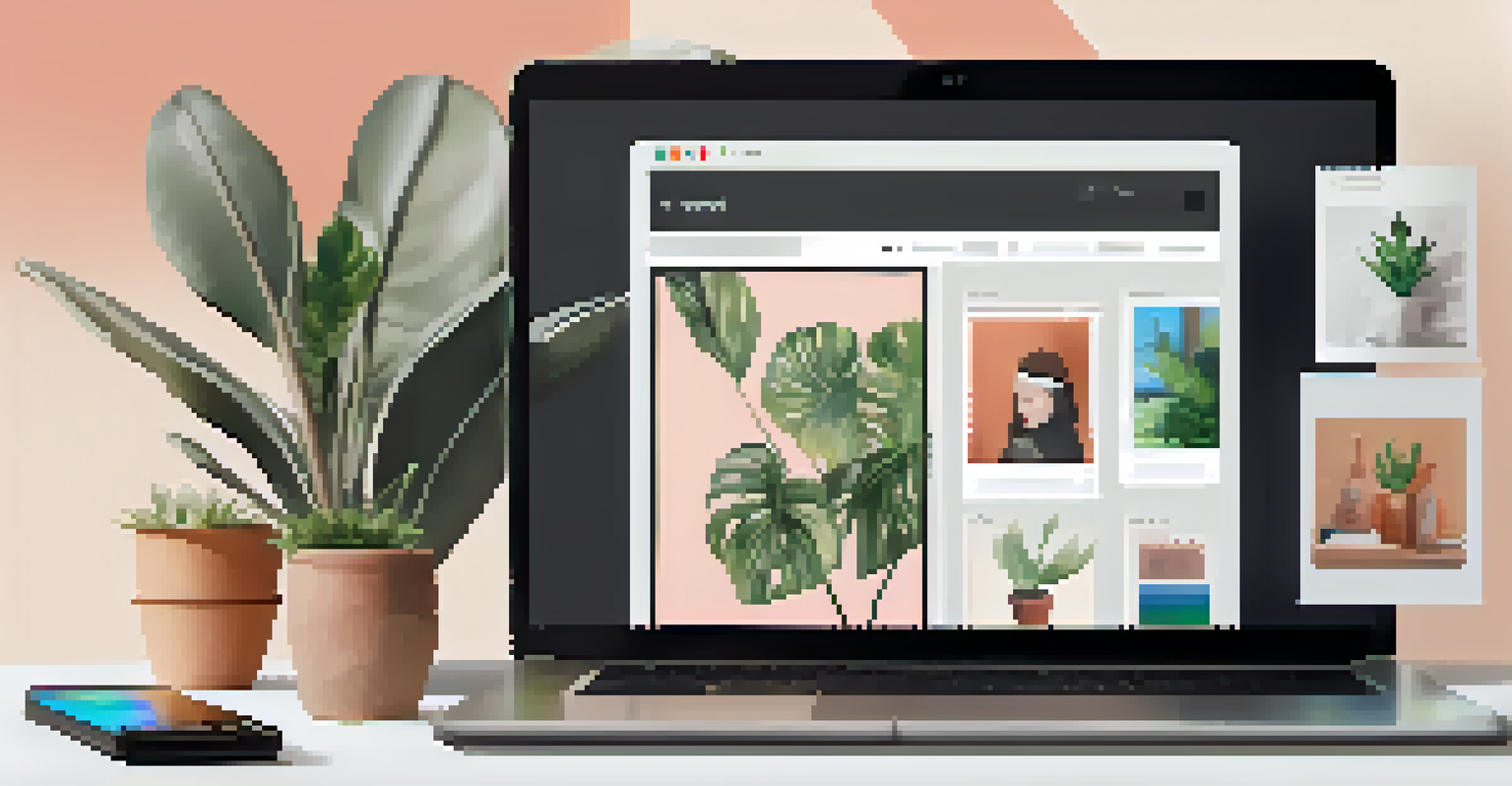The Role of Social Media in Global Art Promotion and Sharing

How Social Media Revolutionizes Art Promotion
In the digital age, social media has become a game-changer for artists. Platforms like Instagram and TikTok allow creators to share their work instantly with a global audience. This shift has democratized art promotion, enabling emerging artists to gain visibility without relying solely on traditional galleries.
The great thing about social media is that it gives everyone a voice and a platform to showcase their art, no matter where they are in the world.
Imagine an artist in a small town who shares their paintings on Instagram. Within days, their work can reach thousands of viewers worldwide, attracting collectors and fans alike. This accessibility fosters a diverse art community, where unique voices can be heard and appreciated.
Social media not only amplifies artists’ reach but also encourages engagement. Viewers can comment, share, and interact with the art, creating a dynamic relationship between creators and their audience. This interaction can lead to collaborations, commissions, and new opportunities that were once hard to come by.
Building a Global Art Community Online
Social media platforms serve as virtual galleries, connecting artists and art lovers from all corners of the globe. Hashtags like #ArtCommunity and #ArtistSupport create digital spaces where creators can showcase their work and support one another. This sense of community is vital for artists, especially those who may feel isolated in their local scenes.

For instance, a sculptor in Brazil might connect with a painter in France through a shared hashtag. They can exchange ideas, share techniques, or even collaborate on projects despite being continents apart. This global networking fosters creativity and innovation, breaking down geographical barriers.
Social Media Empowers Artists
Platforms like Instagram and TikTok enable artists to promote their work globally, fostering visibility and engagement without traditional barriers.
Moreover, social media enables art enthusiasts to discover diverse cultures and styles. Users can explore art from different countries, gaining a broader understanding of global artistic expression. This shared appreciation nurtures a more inclusive art world, where every voice can contribute to the conversation.
The Role of Influencers in Art Promotion
Influencers play a crucial role in shaping art trends and promoting artists on social media. By sharing their favorite works or collaborating with emerging talent, influencers can introduce new art styles to vast audiences. Their endorsement often leads to increased visibility and sales for artists.
Art is not what you see, but what you make others see, and social media helps amplify that vision globally.
Consider a popular influencer who shares a post featuring a unique piece of art. Their followers, intrigued by the aesthetic, may rush to explore the artist’s profile, resulting in a spike in followers and interest. This synergy between influencers and artists creates a mutually beneficial relationship.
Additionally, influencers can help diversify the art scene by spotlighting underrepresented artists. By using their platform to highlight diverse voices, they contribute to a more equitable art world, making it easier for all artists to gain recognition and support.
Engaging Audiences Through Visual Storytelling
Visual storytelling is a powerful tool in art promotion, and social media thrives on it. Artists can share their creative processes, inspirations, and the stories behind their work through videos and images. This transparency builds a deeper connection with the audience.
For example, an artist might post a time-lapse video of their painting process on Instagram. Viewers not only see the final piece but also how it came to life, giving them a greater appreciation for the artist’s skill and effort. This behind-the-scenes glimpse fosters engagement and loyalty among followers.
Building a Global Art Community
Social media connects artists and enthusiasts worldwide, creating a supportive network that encourages collaboration and cultural exchange.
Furthermore, storytelling can enhance an artist's brand. By sharing personal anecdotes and experiences related to their work, artists can cultivate a unique identity that resonates with their audience. This authenticity is key in building lasting relationships in the digital art community.
Challenges of Art Promotion on Social Media
While social media offers incredible opportunities for artists, it also presents unique challenges. The sheer volume of content can make it difficult for individual artists to stand out. With millions of posts shared daily, capturing attention requires creativity and strategic planning.
Additionally, algorithms on platforms like Instagram can limit visibility for some artists, as not all followers see every post. This unpredictability can be frustrating, leading artists to constantly adapt their strategies to maintain engagement. It's a balancing act between staying authentic and adhering to platform trends.
Lastly, the pressure to maintain a constant online presence can lead to burnout. Artists may find themselves spending more time promoting their work than actually creating it. Striking a healthy balance between promotion and artistry is crucial for long-term success and well-being.
Social Media as a Marketplace for Artists
Social media has evolved into a marketplace where artists can sell their work directly to consumers. Platforms like Facebook and Instagram allow for seamless transactions, making it easier for artists to reach potential buyers. This shift has transformed the traditional art sales model.
For instance, an artist can post a piece for sale on their Instagram feed, complete with pricing and payment details, allowing interested buyers to make purchases with just a few clicks. This direct-to-consumer approach eliminates the need for galleries or middlemen, giving artists more control over their sales.
Challenges of Online Art Promotion
Despite its advantages, artists face challenges such as content saturation, algorithm limitations, and the pressure of constant online engagement.
However, this marketplace dynamic also requires artists to become savvy marketers. They need to understand how to promote their work effectively while managing customer relationships. This dual role can be demanding, but it empowers artists in ways that traditional selling methods often did not.
The Future of Art Promotion in the Digital Age
As technology continues to evolve, so too will the landscape of art promotion. Emerging platforms and tools, like virtual reality galleries and AI-generated art, will likely change how artists showcase their work. Staying ahead of these trends will be essential for artists looking to thrive in the digital realm.
Moreover, the integration of blockchain technology could revolutionize how art is bought and sold online. Concepts like non-fungible tokens (NFTs) are already gaining traction, allowing artists to sell digital art in new and innovative ways. This could open up additional revenue streams and broaden artist reach.

Ultimately, the future of art promotion will hinge on adaptability. Artists who embrace new technologies and strategies will be better positioned to navigate the changing landscape. By leveraging social media effectively, they can continue to connect with audiences and flourish in a dynamic art world.